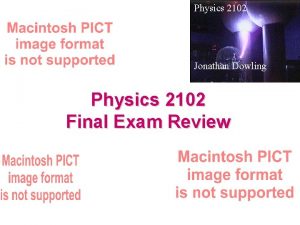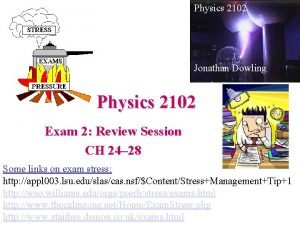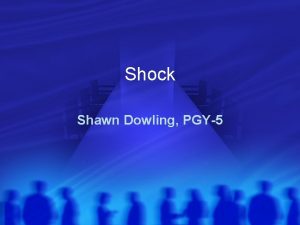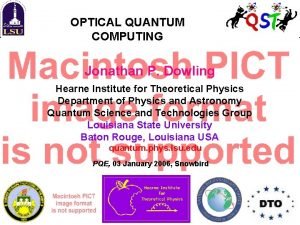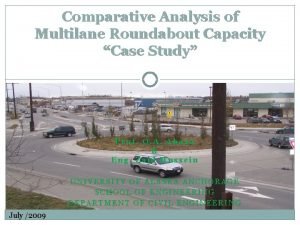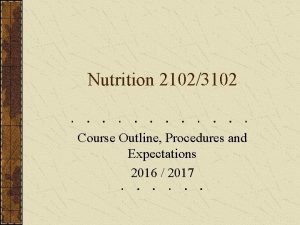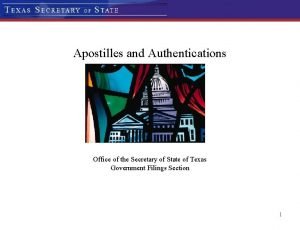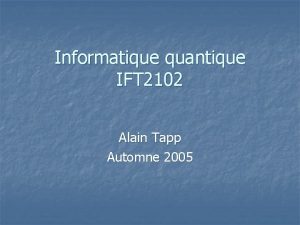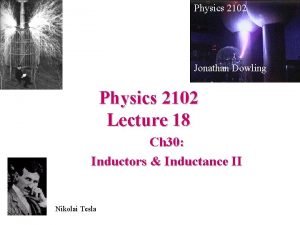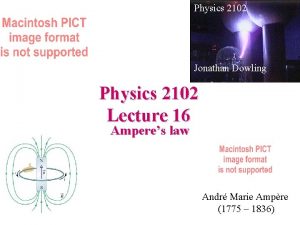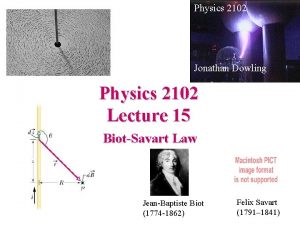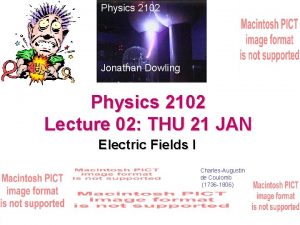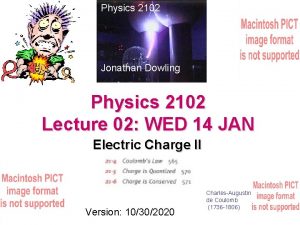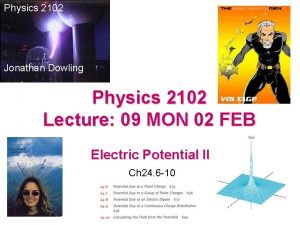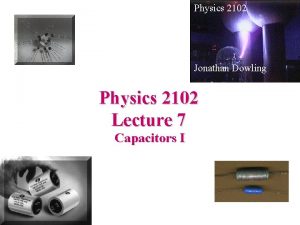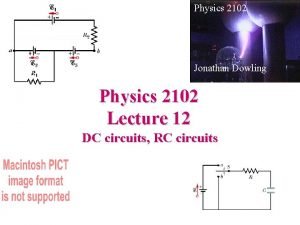Physics 2102 Jonathan Dowling Lecture 27 FRI 20















- Slides: 15

Physics 2102 Jonathan Dowling Lecture 27: FRI 20 MAR Ch. 30. 7– 9 Inductors & Inductance Nikolai Tesla

Inductors: Solenoids Inductors are with respect to the magnetic field what capacitors are with respect to the electric field. They “pack a lot of field in a small region”. Also, the higher the current, the higher the magnetic field they produce. Capacitance how much potential for a given charge: Q=CV Inductance how much magnetic flux for a given current: F=Li Using Faraday’s law: Joseph Henry (1799 -1878)

Self-Inductance L of a Solenoid • Solenoid of cross-sectional area A= r 2, length l, total number of turns N, turns per unit length n • Field inside solenoid: B = 0 n i • Field outside = 0 L = “inductance” i

Example • The current in a L=10 H inductor is decreasing at a steady rate of i=5 A/s. i • If the current is as shown at some instant in time, what is the magnitude and direction of the induced EMF? (a) 50 V (b) 50 V • Magnitude = (10 H)(5 A/s) = 50 V • Current is decreasing • Induced EMF must be in a direction that OPPOSES this change. • So, induced EMF must be in same direction as current

The RL circuit • Set up a single loop series circuit with a battery, a resistor, a solenoid and a switch. • Describe what happens when the switch is closed. • Key processes to understand: – What happens JUST AFTER the switch is closed? – What happens a LONG TIME after switch has been closed? – What happens in between? Key insights: • If a circuit is not broken, one cannot change the CURRENT in an inductor instantaneously! • If you wait long enough, the current in an RL circuit stops changing! At t=0, a capacitor acts like a wire; an inductor acts like a broken wire. After a long time, a capacitor acts like a broken wire, and inductor acts like a wire.

RL circuits In an RC circuit, while charging, Q = CV and the loop rule mean: • charge increases from 0 to CE • current decreases from E/R to 0 • voltage across capacitor increases from 0 to E In an RL circuit, while “charging” (rising current), emf = Ldi/dt and the loop rule mean: • magnetic field increases from 0 to B • current increases from 0 to E/R • voltage across inductor decreases from -E to 0

Example Immediately after the switch is closed, what is the potential difference across the inductor? (a) 0 V (b) 9 V (c) 0. 9 V 10 W 9 V 10 H • Immediately after the switch, current in circuit = 0. • So, potential difference across the resistor = 0! • So, the potential difference across the inductor = E = 9 V!

Example • Immediately after the switch is closed, what is the current i through the 10 resistor? (a) 0. 375 A (b) 0. 3 A (c) 0 40 W 3 V 10 W 10 H • Immediately after switch is closed, current through inductor = 0. • Hence, current through battery and through 10 resistor is i = (3 V)/(10 ) = 0. 3 A • Long after the switch has been closed, what is the current in the 40 resistor? (a) 0. 375 A • Long after switch is closed, potential across (b) 0. 3 A inductor = 0. (c) 0. 075 A • Hence, current through 40 resistor i = (3 V)/(40 ) = 0. 075 A

Fluxing Up an Inductor • How does the current in the circuit change with time? i i(t) Fast/Small � E/R Slow/Large Time constant of RL circuit: = L/R

RL Circuit Movie

Fluxing Down an Inductor The switch is at a for a long time, until the inductor is charged. Then, the switch is closed to b. i What is the current in the circuit? Loop rule around the new circuit: i(t) E/R Exponential defluxing

Inductors & Energy • Recall that capacitors store energy in an electric field • Inductors store energy in a magnetic field. i P = i. V = i 2 R Power delivered by battery = power dissipated by R + (d/dt) energy stored in L

Inductors & Energy Magnetic Potential Energy UB Stored in an Inductor. Magnetic Power Returned from Defluxing Inductor to Circuit.

Example • The switch has been in position “a” for a long time. • It is now moved to position “b” without breaking the circuit. 9 V • What is the total energy dissipated by the resistor until the circuit reaches equilibrium? 10 W 10 H • When switch has been in position “a” for long time, current through inductor = (9 V)/(10 ) = 0. 9 A. • Energy stored in inductor = (0. 5)(10 H)(0. 9 A)2 = 4. 05 J • When inductor “discharges” through the resistor, all this stored energy is dissipated as heat = 4. 05 J.

E=120 V, R 1=10 W, R 2=20 , R 3=30 , L=3 H. 1. 2. 3. 4. 5. What are i 1 and i 2 immediately after closing the switch? What are i 1 and i 2 a long time after closing the switch? What are i 1 and i 2 1 second after closing the switch? What are i 1 and i 2 immediately after reopening the switch? What are i 1 and i 2 a long time after reopening the switch?
 Jonathan dowling
Jonathan dowling Jonathan dowling
Jonathan dowling Shock mnemonic
Shock mnemonic Dowling optical
Dowling optical Dowling roundabout
Dowling roundabout International human resource management dowling 6th edition
International human resource management dowling 6th edition Nutrition 2102
Nutrition 2102 Nutrition 2102
Nutrition 2102 Secretary of state texas apostille
Secretary of state texas apostille Ift-2102
Ift-2102 Nutrition 2102
Nutrition 2102 01:640:244 lecture notes - lecture 15: plat, idah, farad
01:640:244 lecture notes - lecture 15: plat, idah, farad Physics 101 lecture 1
Physics 101 lecture 1 Physics 101 lecture notes pdf
Physics 101 lecture notes pdf Physics 111 lecture notes
Physics 111 lecture notes Waves pdf notes
Waves pdf notes
